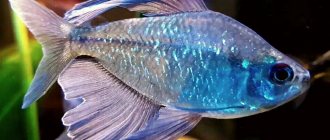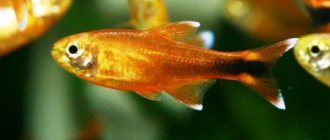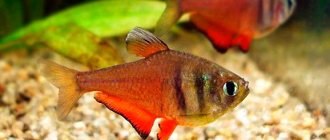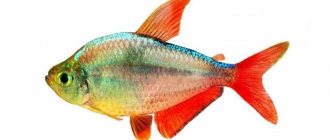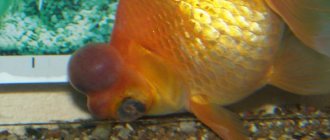Description and natural habitat
The Tetra's homeland is South American reservoirs, where the water is warm all year round, and the bottom is rich in fallen leaves, driftwood and silt, which serve as natural shelters for the fish from large predatory species. Ecuador, Bolivia, Peru, Brazil - the fish is most often found in those countries where the Amazon flows.
The fish itself usually lives in a school; there are also single specimens, but such an individual is either too shy or overly aggressive. School specimens are not afraid of anything, are friendly and peaceful.
Photo gallery of Tetra fish:
Tetras belong to the Characin family and are also predators; in nature they feed on insects, crustaceans, and invertebrates.
In nature and the aquarium hobby, there are many diverse and colorful species of Tetras, but they all have a similar appearance.
The fish have an elongated body, resembling a diamond shape, most often about 5 cm long, although large varieties up to 15-20 cm are also found. These underwater inhabitants have bright and intricately colored scales. Usually calm in nature, but has many small and sharp teeth.
The plumage is not very large; behind the dorsal fin there is often a wen without bony rays.
School individuals are unpretentious, adapt well to any living conditions and live for about 5 years; solitary individuals have a much shorter lifespan, and some especially large specimens live up to 8 years.
Males are usually slightly larger than females and brighter in color. Under unfavorable conditions, their colors become pale.
Aquarium Favorite
Home ponds contain a large number of freshwater fish. One of them belongs to the characidae family, and tetra is the common name for subspecies of this family. The fish “swimmed” into the domestic reservoirs of Europe from the rivers of South America in the 50s of the last century. They found it in warm, shallow rivers, the bottom of which is littered with snags, leaves and entangled with tree roots. This underwater landscape is comfortable for this baby.
Mr. Tail recommends: variety of species
Various color isomorphs of Tetra are found in nature. But most of them:
- Gray with two black transverse stripes on the body.
- Black with blue eyes and red rims around them.
- Gray-red-yellowish, blue, turquoise, red.
The most common and widely used in modern aquarium keeping are listed below.
Copper Tetras
These are the most popular Tetras in artificial home ponds. Their homeland is the southeastern regions of Brazil, the San Francisco River. The length of the diamond-shaped body is about 5-6 cm. Males are bright copper, while females are rather yellowish. A longitudinal stripe of black-bluish color runs along the body, with another one underneath it - golden in males and yellow in females.
The fin plumage of male specimens is brownish-red with yellow markings.
These fish are peaceful, very active and curious, and are not prone to stress.
Puberty occurs early - already at 4-6 months, at this time females become more massive than males, they have a rounded abdomen, and slender males acquire an unusually bright color. This breed is prolific, with a clutch of up to 400-500 sticky and dark eggs.
Lemon Tetras
Or Yellow, they rarely reach 5 cm in length and are distinguished by slender bodies with a small depression near the abdomen. In addition to the main color, the color also contains grayish-greenish shiny tones. Near the gill slits there are two dark oblong marks.
Royal Tetras
Amazing fish of noble color, growing up to 5-7 cm. The almost transparent body has purple, blue or pinkish reflections on the back, a wide dark stripe runs down the middle of the body, and there is a black narrow appendage on the three-lobed tail - a characteristic feature of the Royal Tetra. The dorsal fin is also decorated with saber-shaped rays.
Against the background of dark soil, this luminous fish looks charming.
Palmeri is native to the northwestern part of the Cordillera in Colombia, where the fish live in small streams and pools. The second name of this underwater inhabitant appeared thanks to the name of their discoverer - an American ichthyologist and breeder, collector of rare species.
Juveniles are brown but lighten as they mature. Males have turquoise and black stripes on their bodies, and their eyes become blue. In females they are green. The anal fin has a lilac edge, and on the back and tail the plumage is brownish-red.
Not very prolific, sometimes there are only 50 eggs in a clutch.
False Royal Tetras
Very similar to the previous species, but have an additional adipose fin.
Inpaichthys Kerra or Imperial Tetra is a peaceful schooling fish that, in an aquarium, easily crosses with Copper.
Mexican Tetras
They are also called Blind or Cave fish. These inhabitants of the underwater world are very exotic and require special conditions. But that is precisely why they are valued by aquarists.
The main condition for care is to avoid bright light in the tank; you should use special night lamps with blue and red emission spectra.
In nature, they live in underwater Mexican caves and are not exposed to the sun at all.
They grow up to 9-10 cm, they are almost white with transparent fin plumage and eyes overgrown with film, they are not visible at all.
When this species found itself underground, it practically lost its color pigment, and its vision atrophied as unnecessary, but other senses increased - smell, hearing and lateral lines.
It easily senses the slightest changes in water pressure, quickly navigates in space and finds food. Actively exploring a new body of water, the fish stores a detailed spatial map in its head, which helps it accurately navigate in pitch darkness.
Very prolific, laying up to a thousand eggs. The fry hatch within a day. In the first days of life, their eyes are visible, but as they grow, they become overgrown with a film.
Colombian Tetras
They grow up to 6-8 cm, have a silver belly and a red caudal fin. The back has a bluish tint.
The fish is very calm and peaceful, keeping in a flock of at least ten individuals.
In males, the dorsal fin is slightly higher and brighter than in females, otherwise sexual dimorphism is weakly expressed.
Bloody Tetras
These fish also have names - Callistus or Minor. Its natural habitat is the Paraguay River basin, its numerous backwaters and outflowing streams.
The body is tall and laterally flattened, the back is olive, and the sides are blood-red, which gave rise to the name of the variety. The fins have a charcoal edge, and there is a regular longitudinal spot behind the gill slit.
Males are especially bright during spawning; they resemble a drop of blood, largely due to their small size (no more than 4 cm).
They reach sexual maturity by six months and lay about 300 grayish small eggs.
Golden Tetras
Or Golden, they are distinguished by an ocher-yellow luminous color, a greenish lateral line and the same markings on the head and at the base of the caudal fin. The length of individuals is about 5-6 cm.
Fish love bright light and plants floating on the surface of the water.
Fire Tetras
The firefly is small in size, but very bright. The body is no longer than 3-4 cm and translucent, but along its middle there is a bright longitudinal stripe of red luminous color.
Black Tetras
They are none other than the Ternetias, widely known in the aquarium industry. Dark bodies have two transverse black stripes and luxurious plumage.
A breeding isomorph is also known - the Black Long-finned Tetra, distinguished by its veil-like plumage.
White Tetras
They are artificially bred morphological forms of Blacks. The color of these fish is the same in the location of the markings, but the albino variety has no melanin pigment at all.
Amanda's tetras
Or Red Amandas - tiny fish that live naturally in the waters of the Amazon.
The body and fins are reddish-orange, the belly is slightly lighter. Black eyes are outlined with a golden rim.
Males are slightly smaller and brighter in color, especially during the spawning period, but the size of females rarely reaches 3 cm, usually 1.5-2 cm.
A bright dwarf flock will decorate any artificial pond, especially with dark soil and bright floating plants.
The lifespan of these microscopic fish is shorter than that of other Tetras and rarely reaches 2 years.
They are very unpretentious, reproduce easily, laying 100-150 larvae. At the age of a month, the juveniles develop a characteristic coloration, and by four months they reach sexual maturity.
Diamond Tetras
Or Diamond, their body seems simply sprinkled with these sparkling jewels.
This species was discovered back in 1920 by ichthyologist-researcher Egeimann, and within a decade, amazing fish appeared in European aquariums.
This is an endemic species of Lake Valencia (Tacarigua), located in a mountain valley in northern Venezuela. Now it is widely bred on fish farms in Asia.
The fish grows up to 6 cm and, in addition to its gorgeous color, has rich plumage.
Sexual maturity is reached by the end of the first year of life. They reproduce easily, but tend to eat eggs.
Juveniles are inconspicuous and pale; bright colors appear as they mature.
Tetras Congo
Rainbow or Blue Congos are a Characin population of Africa, described by the biologist Boulanger and found in the Zaire River (modern Congo) in 1899.
One of the most common species in the aquarium hobby, also grown for sale on farms in Thailand and Singapore.
Males are larger and grow up to 8-9 cm, females - up to 5-6 cm.
Silvery bodies have a bright orange line in the middle of the sides and almost transparent, but lush veil-like plumage (in males). Under the rays of light they shimmer with greenish or blue colors.
They lay up to 300 eggs, can breed in schools, and live for about 5 years.
Red-nosed Tetras
Or Rhodostomus, can decorate any aquarium. The fish look very expressive due to their silvery body that plays in the light rays, a bright red spot on the head and a black-striped caudal fin. Despite their small size (up to 4.5 cm females, males are slightly slimmer) they are very loved by aquarists.
When breeding, the softness of the water is very important; in hard water, fertilization of eggs will not occur. These Tetras also differ in that they never eat their eggs. Juveniles grow very slowly and are found in special conditions and on increased nutrition for up to 6 months.
Glass Tetras
Fish that grow up to 6-7 cm and live in natural conditions in Ecuador, Colombia, Peru, Bolivia, Brazil.
The slender and elongated body is almost completely transparent, only the bright red caudal fin stands out. The skin also does not hide anything - the skeleton and internal organs of the fish are visible.
Blue Tetras
Found in the wild in the Amazon and the Marañoni River (Peru). Other names for the fish are Knodus Borki, Boelka and Belkia.
The transparent bluish body on the back has an olive tint and a violet stripe runs along the lateral line.
The fin plumage is almost transparent, the eyes are large and expressive with a reddish rim.
Males are slimmer than females, the maximum size of the latter is 5 cm.
Blue Boelki are very peaceful and calm fish, and a brilliant school of heaven is a true decoration of a pond with dark soil. Powerful lighting is needed so that these pets can be clearly seen.
Tetra Fireflies
Or Erythrosonus, found naturally in the Essequibo, Guyana's longest river. The dark brown water in it contains a lot of tannin, is very soft and acidic.
The long body is greenish-gray or peach, silver and along the lateral line, from head to tail, there is a bright luminous red stripe. It is also present on the transparent dorsal fin and on the head. The black eye is surrounded by a ruby rim on top and heavenly on the bottom.
Males are brighter and slimmer than females. They grow up to 4 cm.
Tetra Penguins
Taierii Crookedbands are greenish-brown-silver fish with a dark stripe along the entire body. This wide line has a yellow edge. They grow up to 7 cm. These are females, males are brighter, slimmer and smaller.
They reach sexual maturity by one year and hatch up to a thousand eggs. They live for about 5 years.
Red-spotted Tetras
Rubrostigma or Ornatus red-spotted grows up to 6-7 cm. On the pinkish silver body in the center there is a characteristic red spot, because of which in some countries breeders call this fish “bleeding heart”.
The male is slightly larger and brighter, has richer plumage, and has black and red stripes on his tail.
Tetragonopterus
Perhaps the most unpretentious Tetras, the disadvantages of which include only the habit of eating aquatic plants. Only Java mosses and anubias do not suffer from their sharp teeth.
The body is large, diamond-shaped, silver-neon with a thin black stripe along the midline. Females reach 7-8 cm, males are slimmer and brighter. The fin plumage is transparent on the chest and back, the rest is red.
Tetra Lanterns
These are small silver-transparent fish (up to 4.5 cm) with a red spot above the eyes. There are also two dark markings - one on the middle of the lateral line, the other near the base of the caudal fin.
Mirror Tetras
Tetra Grima is slightly reminiscent of the Fire Tetra in color; these species are easily crossed.
The main body color is red; when stressed or excited, the scales darken. There are two dark elongated markings above the head, and it also has an adipose fin.
This is a small, peaceful fish that grows to only 4 cm and reaches sexual maturity by one year.
Red Tetras
They have a yellow head, which then turns deep red. Up to the high and short dorsal fin, the body is crossed out by three transverse dark stripes.
Cardinal Tetras
This is a widespread Red Neon, characterized by a bright blue-red luminous color and a narrow long body measuring up to 5 cm.
Tetras and their structural features, as well as differences in gender
As already mentioned, tetra fish are not large. Their body length is only 3-4 cm. The color is brownish or olive, with a white belly. The fins are colored red. Between the head and back there are two dark stripes. Male tetras are more brightly colored than females. Their difference (males) is the presence of a black stripe running along the edge of the anal and ventral fins. The female's tail is pink, while the male's is almost colorless.
Aquarium Basics
Tetras are long-time aquarium inhabitants, but for their prosperous existence near humans they need certain conditions and care:
- First of all, the required hydrochemical parameters in an artificial reservoir should be maintained. The medium should be slightly acidic (5-7 pH) with low carbonate hardness (not higher than 15 dH) and a certain content of tannins - tannins. The temperature required is +22…+26 °C.
- A thermostat, a heater, and an alcohol thermometer with suction cups are required.
- The lighting required is not very bright (the color begins to fade), but slightly dimmed, then the fish is especially beautiful.
- A flock of Tetras looks great in a free tank, so you shouldn’t overload it with decorations, although a certain amount of algae and driftwood is necessary for shelter.
- For a flock of 6 to 10 individuals, a container of 60-100 liters is enough. A rectangular shaped tank is desirable. Round aquariums look very beautiful, but they are unfavorable for the health of its inhabitants, since sound waves in this case are reflected from the walls and have a negative effect on the fish, causing stress.
- Good filtration, aeration and weekly replacement of one-fifth of the water volume are necessary.
- You should use dark small pebbles and river sand as soil; do not place sea stones and shells on the bottom, which increase the hardness of the water. For the required concentration of tannins, it is advisable to put oak and alder leaves on the bottom; driftwood made of oak and ash is also preferable.
- Tetras will not eat aquatic plants if there is an abundance of plant food, so you can decorate an artificial pond with any species, even the most expensive ones. Java mosses, hornworts, thickets of globular cladophora, salvinia, vallisneria, ferns, elodea and riccia are well suited.
What do tetras look like?
All representatives of the species are characterized by:
- Small size. There are “kids” with a body length of 2.5 cm and 15-centimeter “giants”.
- A narrow long body, shaped like a diamond.
- A rich palette of colors, which is determined by the variety. There are elegantly and modestly colored fish, monochrome and multi-colored. Moreover, it is mainly the males that shine with beauty, but the females have a plain appearance. It is interesting that if living conditions worsen, the beauty and brightness of the tetras’ coloring gradually fades away.
- In good conditions they can live up to 5-6 years.
Compatibility
Tetras are fairly calm and peaceful fish that can get along with almost any neighbors. But the ideal would be individuals that are not capable of harming the flock, are similar in size and are non-aggressive:
- angelfish;
- barbs;
- cockerels;
- Corydoras catfish;
- zebrafish;
- discus;
- gourami;
- battles;
- mollies;
- platies;
- plecostomus;
- iris;
- rasboras;
- neons;
- cardinals;
- guppy;
- labeo;
- swordtails.
Neighborhoods with the following species are absolutely not suitable:
- African and South American cichlids;
- goldfish;
- Koi carp;
- astronotuses.
Vegetation
A wide variety of species are planted: ferns, mosses, elodea, duckweed, cryptocoryne. This vegetation does well in low light conditions. But there should be plenty of free swimming space left for the fish. Tetras do not eat plants and do not undermine the soil. It is advisable to equip the aquarium with twisted roots, driftwood, behind which they like to hide, and floating plants for shade.
It is better to place the fish in a stable environment, since changing parameters have a bad effect on their well-being and appearance. The minimum volume of an aquarium for a school of fish of 10 individuals is 70 liters. The tank is placed in a quiet, calm place, since tetras react sharply to activity outside the walls of the aquarium.
Feeding
Tetras are omnivores and will happily eat anything that is offered to them:
- bloodworm;
- Artemia nauplius;
- dry factory and frozen food;
- daphnia;
- scalded and chopped vegetables;
- soaked oatmeal;
- egg yolk.
The main requirement for food is that it floats on the surface, is varied and well-balanced. Plant food is necessary to avoid Tetras from eating aquatic flora.
Breeding
Egg-laying Tetras reproduce quite easily in home aquariums. In the period from 4 to 12 months, individuals become sexually mature (depending on the variety). The first sign of a female’s readiness for mating games is her hiding in thickets of aquatic plants.
If there are 8-10 fish in a school, then, most often, Tetras independently form a pair, which is soon placed in the spawning area.
This tank is pre-prepared by placing Java mosses and a fine-mesh separator mesh on the bottom, filling it with warm water and installing weak filtration and aeration. For about a week, future parents are intensively fed with live food, then the water temperature is raised a couple of degrees and a significant portion of distilled water is added, softening it. Spawning usually occurs in the morning, with 150-200 eggs in the clutch. The parents are removed from the spawning tank; their scales may be cloudy for some time after spawning.
Those eggs that are fertilized are transparent; those that are not fertilized quickly become cloudy. Tetra clutches are very sensitive to fungus and other infections, so it is better to use an ultraviolet sterilizer in the spawning area and keep the lighting dim.
The water temperature is always maintained at +32 °C, and on the third or fourth day the fry will swim on their own.
Juveniles have a high mortality rate in the first days of life; Tetra is perhaps the slowest growing fish.
The first feeding is Artemia nauplius, live dust, ciliates. The fry are kept on such food for almost three months, then larger feeds are introduced.
The temperature should be maintained high until the fourth or even sixth month of life, not lower than +30 ° C, then the growth of the juveniles is slightly accelerated and the survival rate becomes higher.
Reproduction
Tetras can give birth to offspring at the age of about a year. For successful spawning, it is recommended to put the fish on an enhanced diet and carefully monitor their behavior.
The most active pair is placed in a separate container. Usually spawning takes place within the first couple of days . After the eggs have been laid, the female is placed in a common aquarium, and the spawning tank is placed in a warm, shaded place. The fry appear by the end of the week.
Fry
After hatching, the fry can feed on their own. In the first 10–14 days, mashed boiled egg yolk is very useful for them.
Afterwards you can introduce live food. In general , it is recommended to give the fry food from the Tetra line , but for comfortable consumption the food needs to be ground.
Tetras are wonderful fish that are suitable for both beginner and experienced aquarists. Their unpretentiousness and peaceful disposition make it easy to find neighbors for them, and their bright colors will prevent them from getting lost even in a large tank.
Diseases and prevention
Tetras are prone to all the diseases common to underwater inhabitants. Most often, pathologies arise when conditions of detention are violated. Immediately the brightness of the scales disappears, and gradually the fish may become completely discolored. Stress also contributes to this.
Common diseases of Tetra include typical lesions of tropical fish:
- Acidosis and alkolosis. These are conditions that occur when acidity levels become too high (alkolosis) or too low (acidosis). In the acute course of the disease, the fish become excited and rapidly “jump” around the pond. In chronic cases, breathing difficulties and coughing gradually appear. You can only try to save your pets by gradually equalizing the pH level.
- Osmotic stress. They occur when the water-salt balance is disturbed and the water composition is incorrect. Salvation lies in maintaining proper parameters and immediately resolving them in case of violations.
- Dermatomycoses. There are many of them - saprolegniosis, achlyosis, branchiomycosis (gill rot), ichthyophonosis, and other systemic mycoses. In all cases, pets are affected by various types of fungal parasites. For treatment, Malachite green, Methylene blue, and other special preparations from aqua salons are used. And to prevent pathology, it is necessary to keep the tank clean, use high-quality food and do not forget about preliminary quarantine for new pets.
Results
Thus, final conclusions can be drawn about this breed of the characin family. The tetra is a small, brightly colored fish that comes in many unique varieties. She has a peaceful character, lives in flocks, is unpretentious in maintenance and is quite easy to breed. The tetra will make a wonderful pet and will give its owner many pleasant moments of contemplation, filled with peace and tranquility.

